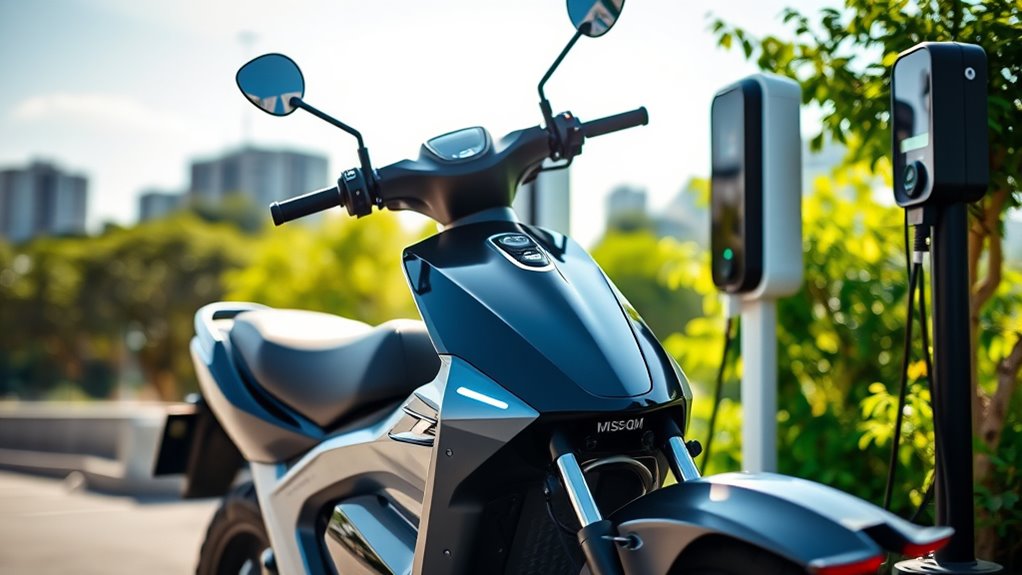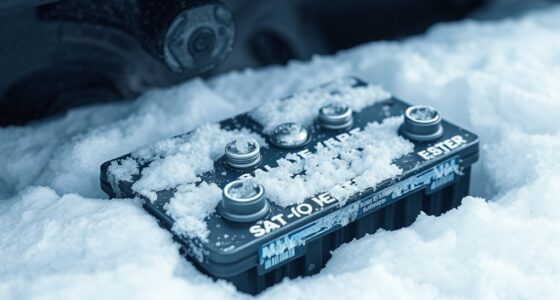To charge your electric motorbike safely and efficiently, understand your battery’s capacity and chemistry, then choose the right charger—Level 1, Level 2, or DC fast charging—based on your needs. Use compatible outlets and connectors, avoid extension cords, and charge in a dry, ventilated area. Monitoring your battery’s temperature and avoiding overcharging helps prolong its life. Keep your skills sharp to maximize range and safety; more tips await if you go further.
Key Takeaways
- Use chargers compatible with your battery’s voltage, capacity, and connector type to ensure safety and optimal performance.
- Choose the appropriate charging level (Level 1, 2, or DC fast) based on your riding needs and desired charging speed.
- Monitor battery temperature and avoid overcharging, aiming for about 80% charge to prolong battery lifespan.
- Plan routes with access to reliable charging stations, especially fast chargers, for longer trips and minimal downtime.
- Follow safety practices: use grounded outlets, avoid extension cords, and disconnect only after charging is complete.
Understanding Your Electric Motorcycle Battery

Understanding your electric motorcycle battery is essential for safe and efficient charging. Your battery capacity, measured in kilowatt-hours (kWh), impacts your riding range and helps you plan charging routines effectively. Most electric bikes use lithium-ion batteries because they offer high energy density and a long cycle life. Knowing your battery’s voltage and capacity allows you to select compatible chargers, ensuring safe and efficient charging. Proper identification of your li-ion batteries prevents potential damage and optimizes performance. Familiarity with your battery’s features also helps extend its lifespan and maintain safety standards. Additionally, understanding the benefits of proper maintenance can significantly enhance your battery’s longevity. Recognizing the importance of battery compatibility ensures you use the right chargers and avoid damaging your motorbike’s electrical system. Being aware of industry trends can also help you stay updated on new charging technologies and safety standards. Staying informed about regulatory standards can help you ensure compliance and safety during charging. Moreover, understanding your battery’s state of charge allows you to prevent overcharging and undercharging, which can degrade battery health over time. By understanding these aspects, you can prevent overcharging or using incompatible chargers, ultimately keeping your motorcycle running smoothly and safely for longer periods.
Exploring Different Charging Levels and Their Benefits
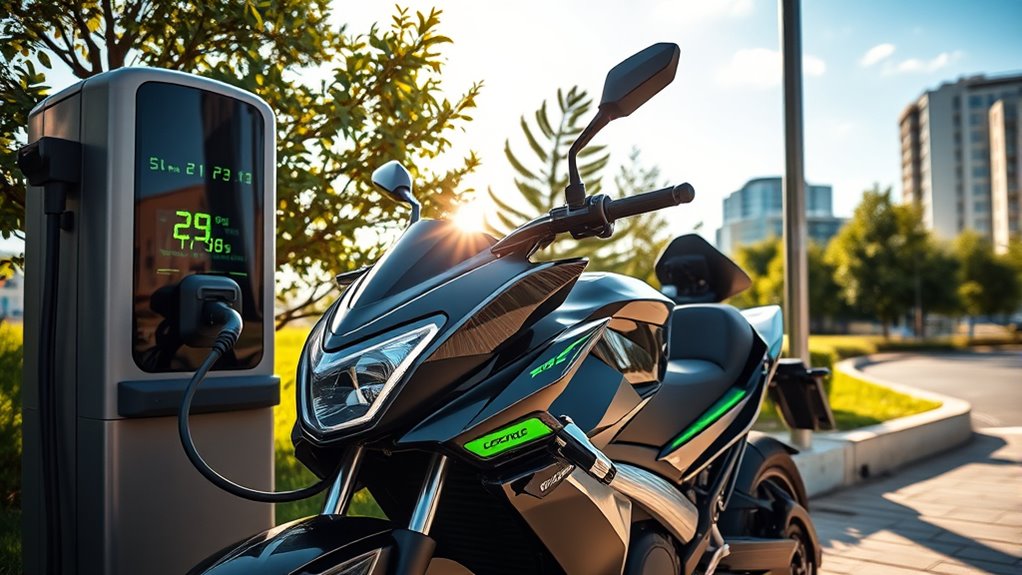
Exploring different charging levels helps you choose the most suitable method for your riding needs. Level 1 charging uses standard 120-volt outlets, providing about 10 miles of range per hour—ideal for overnight charging. Level 2 charging operates at 240 volts, speeding up charging times to roughly 30 miles per hour, perfect for quick top-ups at home or public stations. Be cautious of dangerous charging; using incompatible chargers can harm your battery. Consider your daily riding distance and schedule when choosing a level. Fast DC charging offers 60-100 miles in just 20-30 minutes but may impact long-term battery health. Here’s a quick comparison:
| Charging Level | Charging Times | Benefits |
|---|---|---|
| Level 1 | Several hours (overnight) | Gentle on battery, simple |
| Level 2 | 3-8 hours | Faster, convenient |
| DC Fast | 20-30 minutes | Rapid, ideal for long trips |
Additionally, understanding the battery management system can help optimize charging practices and prolong your electric motorbike’s lifespan. Being aware of the performance characteristics of your battery can also guide you in maintaining optimal charge levels for better efficiency. Regularly monitoring battery health can prevent unexpected failures and extend the overall lifespan of your vehicle, especially through proper charging habits. Incorporating proper maintenance practices ensures your battery remains reliable and performs efficiently over time.
Selecting the Appropriate Charger for Your Bike
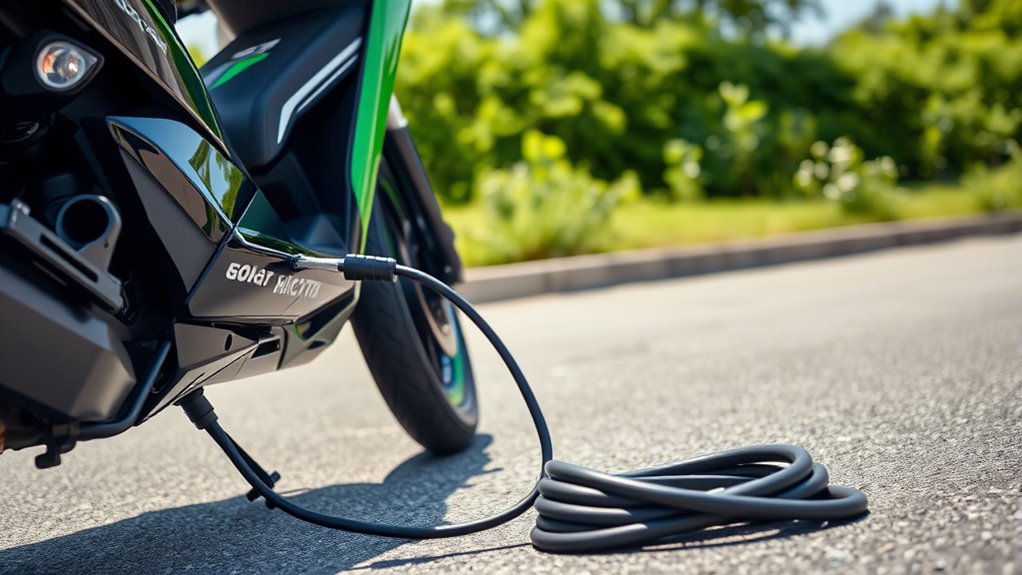
Choosing the right charger guarantees your bike charges safely and efficiently. Make sure the charger matches your battery’s voltage and current needs, and check that the connector type fits public stations. Consider charging speed and whether onboard or external chargers suit your routine best. Using a charger with proper power specifications can help prevent battery damage and ensure optimal performance. Additionally, selecting a charger with the appropriate compatibility with battery chemistry is essential to maintain battery health over time. It is also important to verify that the charger provides safe and reliable operation, especially when used frequently or in different environments. Being aware of charging protocols can further optimize your charging process and prolong battery lifespan. For optimal safety, always follow manufacturer guidelines and consider environmental conditions that may affect charging efficiency.
Compatibility With Battery
Selecting the right charger for your electric motorbike is essential to guarantee safe, efficient, and reliable charging. You need to certify battery compatibility by choosing a charger that matches your battery chemistry, like lithium-ion, and follows the correct charging profile to prevent damage and optimize longevity. Check that the charger outlet socket and connector type align with your bike’s specifications, such as Type 2 or a standard AC plug. Verify that the charger’s power output suits your battery’s capacity and onboard charger ratings to avoid overload. Additionally, confirm compatibility with public or fast chargers by matching voltage and current ratings. Using the manufacturer-recommended charger is the best way to maintain battery health and keep your warranty intact. Practicing self-awareness about your charging habits can also help prolong your battery’s lifespan and ensure optimal performance over time. Being familiar with battery chemistry and its specific charging requirements is crucial for optimal maintenance and safety. Understanding charger compatibility ensures your bike charges efficiently without risking damage to the battery or charger. Moreover, paying attention to charging station standards can help you select appropriate public charging options and avoid compatibility issues. Keeping informed about industry regulations can also help you stay compliant and safe during charging.
Charger Types and Features
When it comes to charging your electric motorbike, understanding the different charger types and their features is essential for peak performance and convenience. The main charger types are onboard chargers integrated into the electric motorcycle and external offboard chargers. Onboard chargers usually connect directly to standard household outlets, offering a slower charging rate suitable for overnight top-ups, with power ratings from 1.4 kW to 3.3 kW. External chargers often support faster charging, delivering up to 6.6 kW or more, so you can get back on the road quicker. Choosing the right charger depends on your bike’s voltage and capacity. Level 1 chargers are common for basic overnight charging, while Level 2 chargers provide a higher charging rate and faster top-ups, making them ideal for regular use. Additionally, selecting a charger with high-quality energy efficiency can help reduce energy consumption and lower overall charging costs.
Charging Speed and Efficiency
To guarantee your electric motorbike charges efficiently, it’s essential to match your charger’s capacity with your bike’s onboard system. The charging speed depends on the charger’s Level and its compatibility with your bike’s chargepoint. Level 1 chargers, using 120V outlets, typically deliver around 1-2 kW, making them slower but widely compatible. Level 2 chargers, which operate at 240V, can provide between 3-11 kW, considerably reducing charging times if your bike supports this level. For faster charging, DC fast chargers offer 50-150kW, but your bike must support high-power DC charging. Using a charger that matches or exceeds your onboard capacity ensures peak efficiency without risking damage, maximizing your ride time and minimizing charge duration.
Charging Your Electric Motorbike at Home Safely
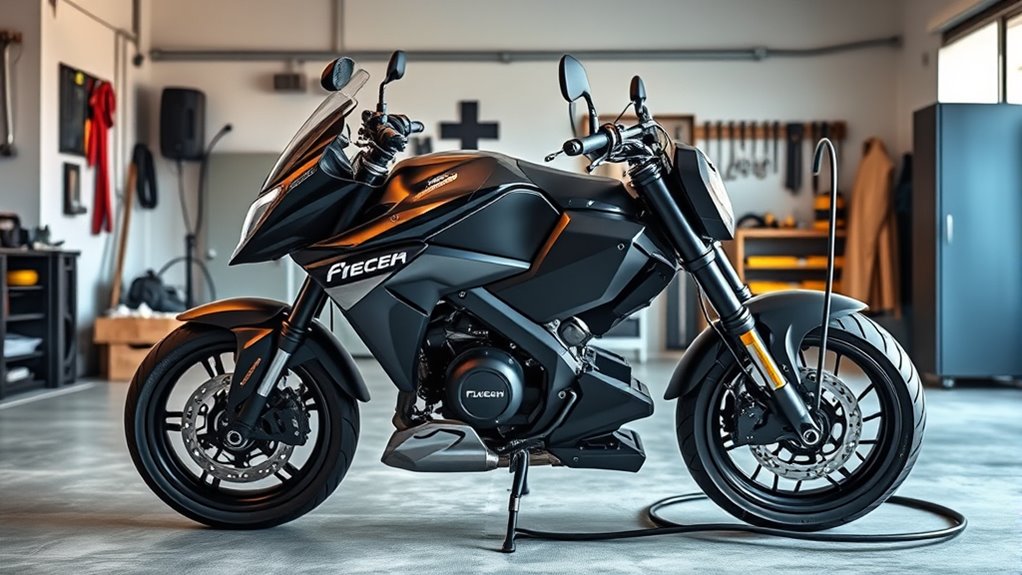
Charging your electric motorbike at home can be safe and straightforward if you follow proper procedures. Use a dedicated, grounded 120V household outlet for your home charging setup to guarantee safety. Always connect the charger securely to the bike’s inlet socket, making sure all connections are tight before starting the charging process. Avoid using extension cords or adapters that aren’t approved by the manufacturer, as these can pose electrical hazards. Keep the charging area dry, well-ventilated, and avoid charging in direct sunlight or extreme temperatures. Remember to unplug the charger from the power source before disconnecting it from your bike to prevent electrical shocks. Following these safety steps ensures a smooth, secure home charging experience for your electric motorbike.
Using Public Charging Stations Effectively
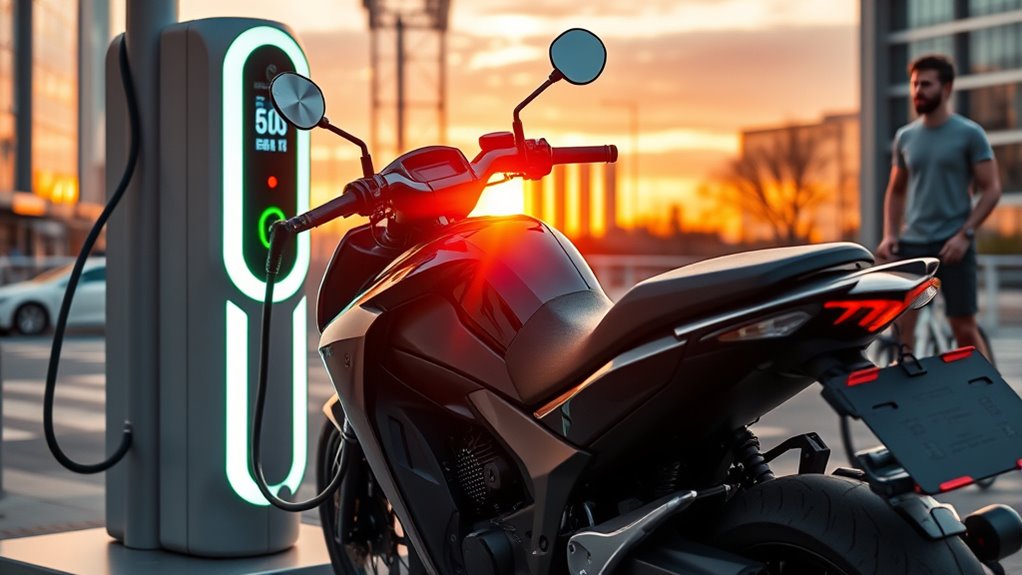
Using public charging stations offers a convenient way to top up your electric motorbike when you’re away from home. To do so effectively, verify that the station’s connector type matches your bike’s inlet, such as Type 2 or CCS, to guarantee compatibility. Use apps like PlugShare or ChargePoint to locate nearby stations, check real-time availability, and confirm station specs. Follow station instructions carefully—initiate charging via RFID, app, or touchscreen, and securely plug in your bike. Monitor the process through the station display or your app, disconnect only after charging completes to avoid damage. Be aware of operating hours, payment methods, and fees. Always inspect equipment for safety before use. Here’s a quick guide:
| Connector Type | App Usage | Compatibility |
|---|---|---|
| Matches your inlet | Check real-time info | Ensures safe, efficient charging |
| Different types | Locate nearby stations | Prevents connection issues |
| Secure connection | Follow instructions | Avoid damage or errors |
| Monitor & disconnect | Confirm full charge | Maintains safety & battery health |
Tips for Maintaining Battery Health During Charging
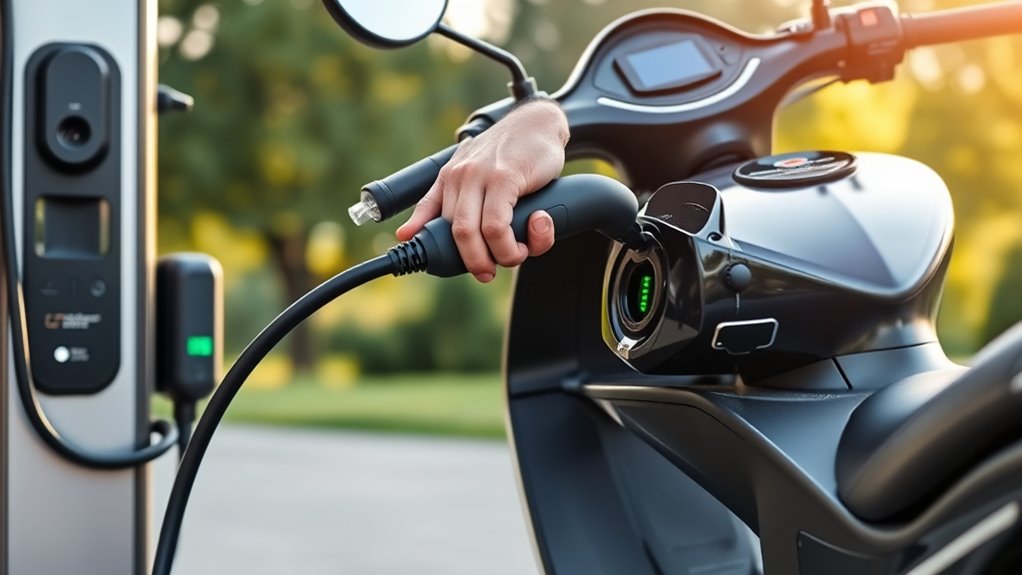
To keep your battery healthy during charging, pay attention to temperature and timing. Avoid charging in hot environments and aim for cooler, shaded spots to prevent damage. Also, don’t forget to charge to about 80% and prevent frequent deep discharges for ideal battery longevity.
Battery Temperature Control
Keeping your electric motorbike’s battery at a cool temperature during charging is essential for maintaining its health and lifespan. Aim for a battery temperature between 20°C and 25°C to prevent accelerated degradation. Charging in a hot environment above 30°C can cause overheating, increasing the risk of damage. To keep temperatures in check, choose a well-ventilated charging environment with good airflow, avoiding direct sunlight or hot spots. Proper ventilation helps dissipate heat and prevents temperature spikes. Monitoring your battery’s temperature with built-in sensors or external tools can alert you if it gets too hot. By controlling the battery temperature during charging, you’ll ensure a longer-lasting, healthier battery and a more reliable ride.
Charging Frequency and Timing
Charging your electric motorbike at appropriate times and frequencies is essential for preserving battery health. Keep your charging frequency moderate by recharging when the battery drops to around 20-30%, avoiding deep discharges that can harm the cells. Instead of full 100% charges every time, aim for ideal charging around 80%, which reduces heat buildup and stress on the battery. Regular, moderate charge cycles are better for maintaining consistent performance and prolonging battery lifespan. Avoid high-temperature environments during charging, as heat accelerates degradation. Using a smart charger that monitors and controls the charge cycle can help prevent overcharging and overheating, ensuring your battery remains in peak condition. Proper timing and frequency are key to maximizing your electric motorbike’s battery life.
Planning Routes With Charging Stops in Mind
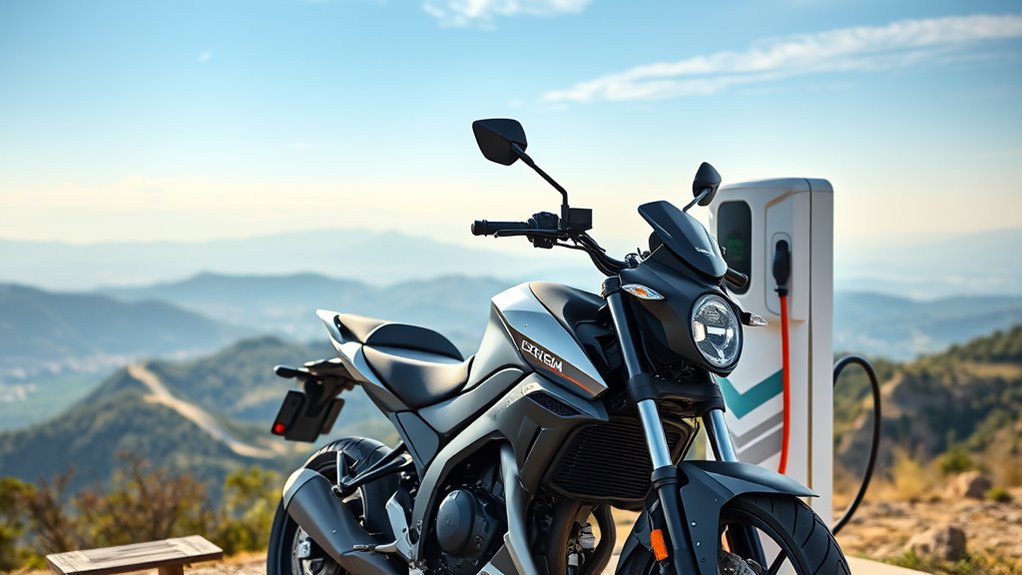
Planning your route carefully guarantees you won’t run out of power before reaching your next charging station. Use apps like Electrify America, EVgo, ChargePoint, or Google Maps to locate charging stations along your route. Prioritize stations that support fast charging (DC Fast Charging) to reduce downtime during long trips. Incorporate multiple charging stops where you plan to charge up to 80% rather than full 100%, optimizing charging time and preserving battery health. Tools like A Better Route Planner (ABRP) help map out the best route based on your motorcycle’s range and station capabilities. Always add buffer time at each stop to account for station availability, potential wait times, and varying charging speeds. Good route planning guarantees a smooth, efficient journey.
Best Practices for Fast and Efficient Charging
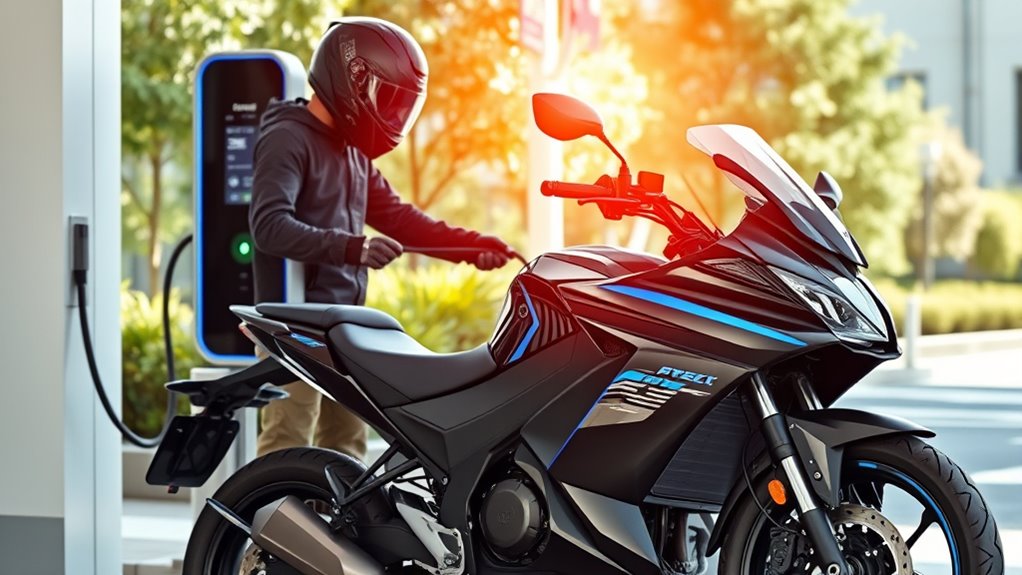
To make the most of fast charging stations, it’s important to follow best practices that maximize efficiency and protect your battery. Use DC Fast Charging stations supporting 50kW or more to quickly add 60-100 miles of range in just 20-30 minutes, ideal for electric motorcycles. Aim to charge up to 80% instead of 100%, reducing battery wear and cutting down charging time considerably. When charging, connect to a chargepoint via a cable securely, ensuring proper contact. If using a standard household outlet, opt for a smart charger that can optimize charging parameters and prevent thermal damage. Always monitor your battery’s temperature, especially in hot conditions, to maintain charging efficiency and prolong battery life. Proper planning and adherence to these practices ensure fast, safe, and efficient charging.
Keeping Your Battery in Optimal Condition During Storage
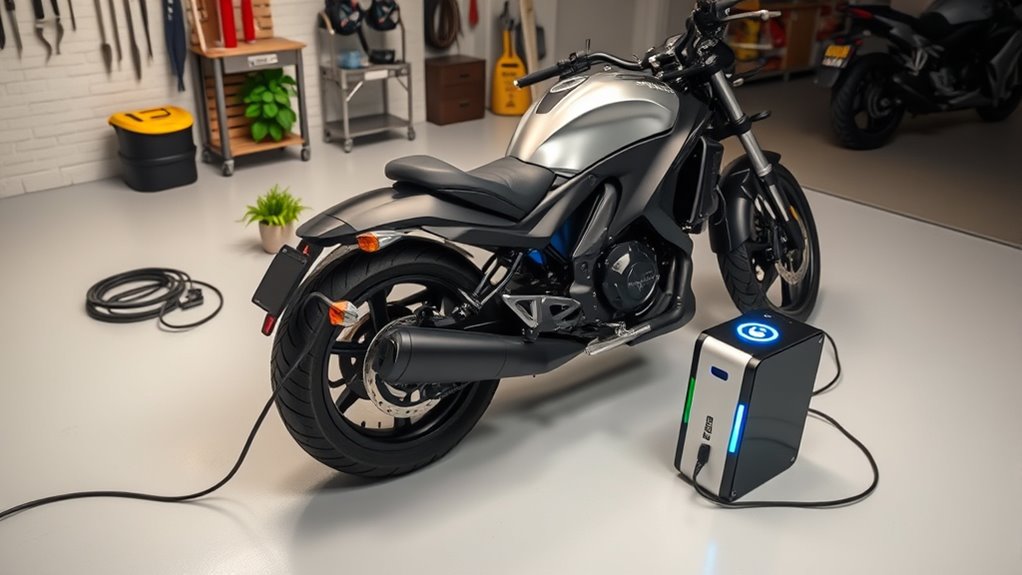
When storing your electric motorbike for an extended period, maintaining the battery’s health is essential to prevent capacity loss. Keep the battery in storage with a charge level between 20% and 80%, as this range helps preserve its capacity. If you’ll be storing the bike for more than 30 days, disconnect the battery to avoid parasitic drain and potential damage. Store the battery in a cool, dry environment, ideally between 15°C and 25°C, to keep it in peak condition. Regularly check the charge level every 4-6 weeks and recharge to the recommended level if needed. Follow your manufacturer’s storage guidelines, including any specific maintenance or periodic charging routines, to extend your battery’s lifespan and ensure it stays healthy during long-term storage.
Frequently Asked Questions
How to Charge an Electric Motorbike?
To charge your electric motorbike, you connect it to a compatible charger, making sure the port and connector are clean and aligned. Use the onboard charger for Level 1 or 2, or a DC fast charger if available. Follow manufacturer instructions for charging times, monitor the indicators, and unplug carefully once the battery reaches the desired level, usually around 80%. Always handle connections gently to protect your bike and yourself.
What Do You Need to Charge an Electric Bike?
Charging your electric bike is like fueling a vehicle with precision. You need a compatible charging cable that connects your bike’s inlet socket to a power source, like a standard outlet or charging station. Make sure you have the right charger for your model, and confirm the power source is grounded and capable of delivering sufficient current. Check connector types at public stations, and use apps if needed to start charging safely.
How Long Does It Take to Fully Charge an Electric Motorcycle?
When you ask how long it takes to fully charge an electric motorcycle, it depends on the charger type and battery size. For a typical 7.2 kWh battery, a standard Level 1 charger needs around 3 to 5 hours. Level 2 chargers can do it in 1 to 2.5 hours. Fast DC chargers can bring your battery to 80% in just 20 to 30 minutes, making quick stops convenient.
What Are the Rules for Electric Motorcycles?
Think of riding your electric motorcycle as dancing with the law. You must follow local licensing and registration rules, wear approved safety gear, and adhere to speed limits. Be mindful of restricted zones like highways or city centers, and use charging stations legally. Parking rules matter too—ignore them, and you risk fines. Staying compliant keeps your ride smooth, safe, and in tune with local regulations.
Conclusion
Charging your electric motorbike might seem intimidating at first, but with the right knowledge, it becomes second nature—like riding a bike itself. By understanding your battery, choosing the right charger, and adopting good habits, you’ll keep your bike running smoothly and extend its lifespan. Remember, every charge is a step toward a greener future. So, embrace these tips and turn every ride into a journey of power and possibility—your adventure awaits!
